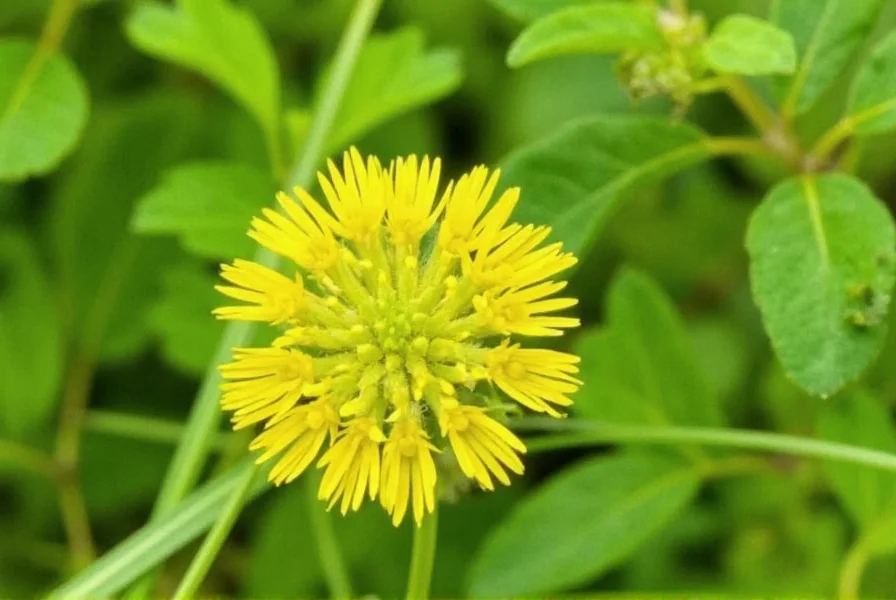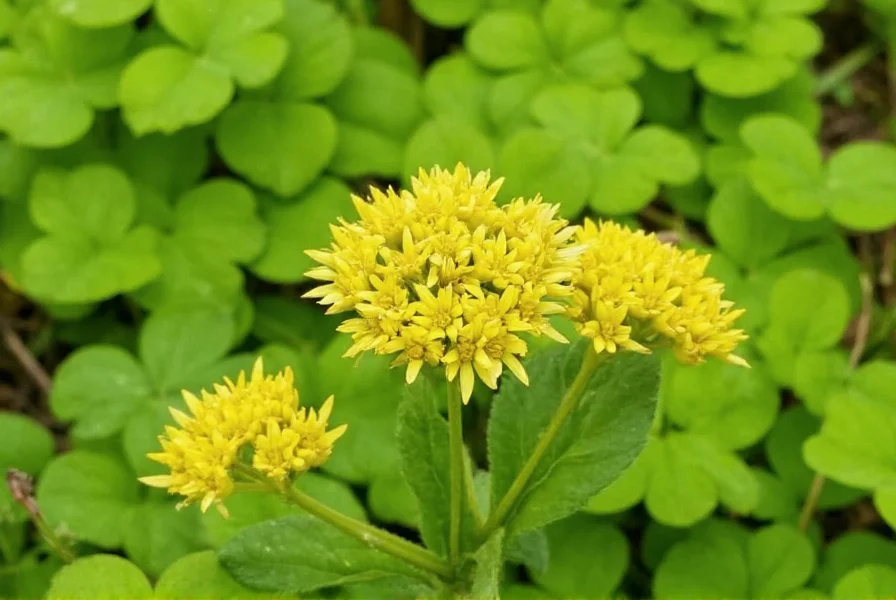Golden clover, scientifically classified as Trifolium aureum, stands as one of the most visually striking members of the clover family. This perennial herbaceous plant belongs to the Fabaceae family and has been utilized for centuries in agricultural and ecological applications. Understanding the specific characteristics of golden clover plant helps gardeners, farmers, and nature enthusiasts identify and utilize this valuable species effectively.
Botanical Characteristics of Golden Clover
Golden clover exhibits several distinctive features that set it apart from other clover varieties. The plant typically reaches heights between 10-50 centimeters, with hollow, upright stems that branch near the base. Its trifoliate leaves consist of three oval-shaped leaflets with smooth edges, each measuring 1-3 cm in length. What truly distinguishes golden clover from white clover and red clover is its vibrant yellow flower heads.
The flower heads of Trifolium aureum form dense, spherical clusters approximately 1-2 cm in diameter. These bright yellow blooms appear from late spring through summer and emit a subtle sweet fragrance that attracts pollinators. As the flowers mature, they develop into small pods containing the plant's seeds. The golden clover vs white clover comparison reveals significant differences in flower color, growth habit, and preferred growing conditions.
Habitat and Growing Requirements
Native to Europe and Western Asia, golden clover has adapted to various environments but shows preference for specific conditions. Understanding how to identify golden clover in the wild requires knowledge of its typical habitat:
- Soil: Prefers well-drained, sandy or loamy soils with neutral to slightly alkaline pH
- Sunlight: Thrives in full sun exposure, though tolerates partial shade
- Moisture: Moderate water requirements; more drought-tolerant than white clover
- Temperature: Grows best in temperate climates, hardy to USDA zones 4-8
When considering growing golden clover in gardens, proper soil preparation proves essential. The plant establishes best when seeds are sown in early spring or fall. Unlike some clover varieties, golden clover doesn't tolerate waterlogged conditions, making proper drainage crucial for successful cultivation. The benefits of golden clover for soil health stem from its nitrogen-fixing capabilities, enriching the earth for subsequent plantings.
| Characteristic | Golden Clover | White Clover | Red Clover |
|---|---|---|---|
| Scientific Name | Trifolium aureum | Trifolium repens | Trifolium pratense |
| Flower Color | Bright yellow | White/pink | Red/purple |
| Height | 10-50 cm | 5-20 cm | 20-80 cm |
| Soil Preference | Well-drained, sandy | Moist, fertile | Loamy, well-drained |
| Nitrogen Fixation | High | Moderate | High |
Practical Applications and Benefits
Golden clover serves multiple valuable purposes across agricultural and horticultural settings. Its nitrogen-fixing properties make it an excellent choice for soil improvement in crop rotation systems. Farmers often incorporate golden clover into pasture mixes due to its high nutritional value for livestock. The plant's deep root system also helps break up compacted soil and improve soil structure.
For gardeners interested in growing golden clover as a ground cover, the plant offers several advantages. It establishes relatively quickly, suppresses weeds, and requires minimal maintenance once established. Unlike aggressive ground covers, golden clover remains manageable and doesn't typically invade garden beds. The golden clover plant characteristics make it particularly suitable for sunny borders, meadow gardens, and erosion control on slopes.
Regarding the question of whether golden clover is edible, historical records indicate that young leaves and flowers were occasionally used in salads or as pot herbs. However, modern consumption is rare, and it's not commonly recommended for human consumption without proper preparation. The is golden clover edible question requires careful consideration, as some clover species contain compounds that may cause digestive issues when consumed in large quantities.
Cultural Significance and Symbolism
Unlike the four-leaf white clover, which carries significant luck symbolism in many cultures, golden clover doesn't share the same legendary status. The bright yellow flowers have been associated with sunshine and vitality in some folk traditions, but it lacks the widespread cultural significance of its white counterpart.
Some confusion exists between golden clover and the mythical "golden" four-leaf clover. The latter refers to a rare genetic mutation in white clover that supposedly brings extraordinary luck, not to the naturally yellow-flowered Trifolium aureum. Understanding this distinction helps clarify the golden clover vs four-leaf clover misconception that often appears in popular culture.
Growing Golden Clover Successfully
For those interested in cultivating golden clover, proper planting techniques ensure the best results. The growing golden clover in gardens process begins with soil preparation—amending heavy soils with sand or compost to improve drainage. Seeds should be surface-sown and lightly pressed into the soil, as they require light for germination.
Watering should be consistent but not excessive during establishment. Once mature, golden clover demonstrates good drought tolerance. The plant typically blooms in its first or second year and self-seeds readily in favorable conditions. For agricultural applications, golden clover works well in mixtures with other legumes and grasses, providing balanced forage and soil benefits.

Common Questions About Golden Clover
Many gardeners and nature enthusiasts have specific questions about this distinctive plant. Understanding the answers helps make informed decisions about whether to incorporate golden clover into landscapes or agricultural systems.
Is golden clover rare in the wild?
Golden clover isn't considered rare in its native European and Western Asian habitats, where it commonly grows in grasslands, roadsides, and disturbed areas. However, it's less widespread than white clover in many regions. In North America, where it's been introduced, golden clover appears less frequently than other clover species, making sightings somewhat special for plant enthusiasts.
What are the medicinal uses of golden clover?
Historically, golden clover hasn't been as widely used medicinally as red clover. Some traditional applications included using the flowers for mild respiratory issues, but scientific evidence supporting these uses is limited. The golden clover medicinal uses remain largely undocumented in modern herbal medicine, unlike red clover which has more research backing certain applications. Always consult a healthcare professional before using any plant medicinally.
How does golden clover benefit wildlife?
Golden clover provides significant benefits to pollinators, particularly bees and butterflies, which are attracted to its nectar-rich yellow flowers. The plant serves as a valuable food source during its blooming period. Additionally, the seeds provide nutrition for certain bird species. In agricultural settings, golden clover supports beneficial insect populations that help control pest species, contributing to a balanced ecosystem.
Can golden clover be used as a lawn alternative?
While golden clover can grow in lawn-like settings, it's not typically recommended as a primary lawn alternative. Unlike white clover, which tolerates frequent mowing and foot traffic, golden clover prefers less disturbance. It works better as a companion plant in meadow lawns or in areas where a more natural, less manicured appearance is desired. For traditional lawn replacement, white clover or micro-clover varieties generally perform better under regular mowing and foot traffic.
How long does golden clover bloom?
Golden clover typically blooms from late spring through mid-summer, with the flowering period lasting approximately 6-8 weeks depending on climate conditions. In ideal growing conditions with adequate moisture, blooming may extend longer. The bright yellow flower heads appear progressively, with individual flowers opening over several days. In cooler climates, the blooming period may be slightly shorter than in temperate regions where golden clover grows most vigorously.











 浙公网安备
33010002000092号
浙公网安备
33010002000092号 浙B2-20120091-4
浙B2-20120091-4